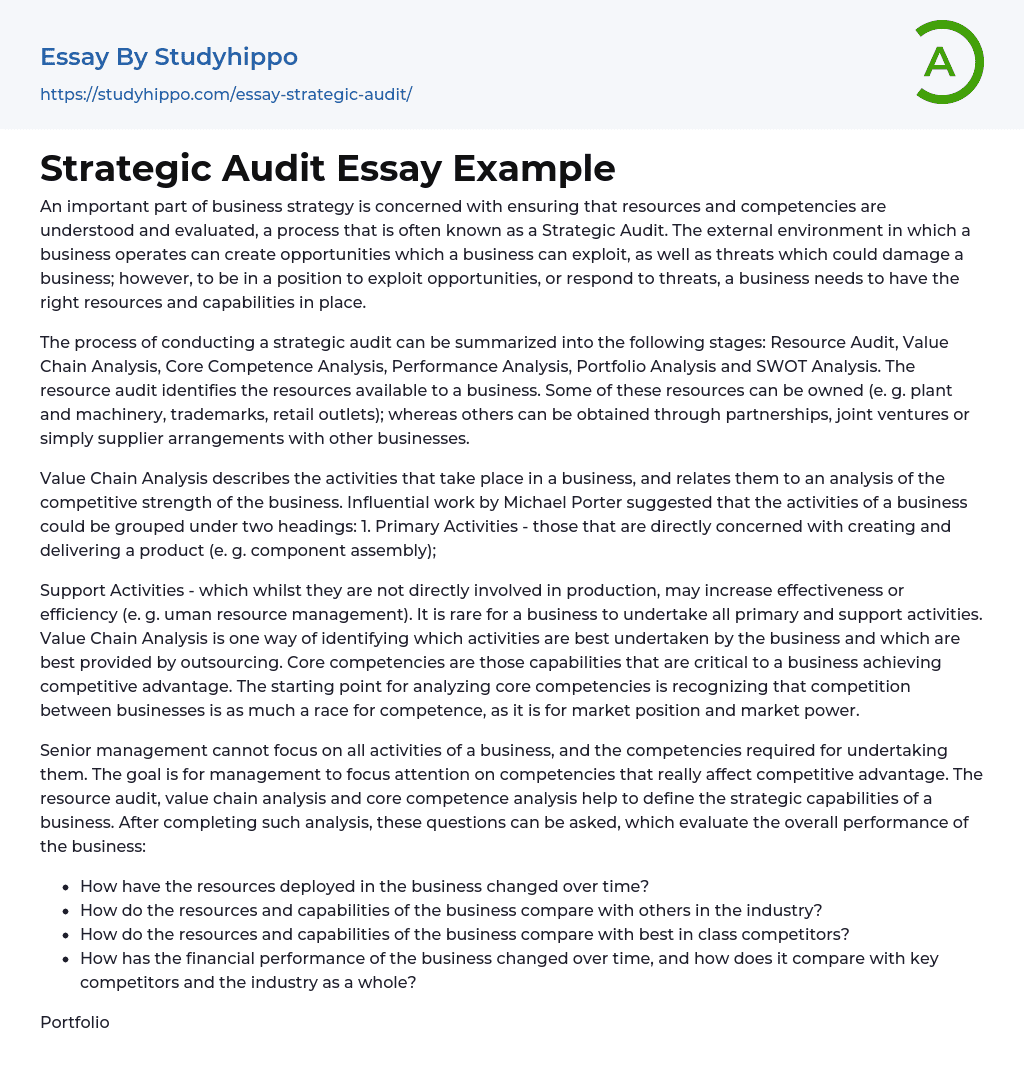An important part of business strategy is concerned with ensuring that resources and competencies are understood and evaluated, a process that is often known as a Strategic Audit. The external environment in which a business operates can create opportunities which a business can exploit, as well as threats which could damage a business; however, to be in a position to exploit opportunities, or respond to threats, a business needs to have the right resources and capabilities in place.
The process of conducting a strategic audit can be summarized into the following stages: Resource Audit, Value Chain Analysis, Core Competence Analysis, Performance Analysis, Portfolio Analysis and SWOT Analysis. The resource audit identifies the resources available to a business. Some of these resources can be owned (e. g. plant and machinery, trademarks, retail outlets); whereas others can be ob
...tained through partnerships, joint ventures or simply supplier arrangements with other businesses.
Value Chain Analysis describes the activities that take place in a business, and relates them to an analysis of the competitive strength of the business. Influential work by Michael Porter suggested that the activities of a business could be grouped under two headings: 1. Primary Activities - those that are directly concerned with creating and delivering a product (e. g. component assembly);
Support Activities - which whilst they are not directly involved in production, may increase effectiveness or efficiency (e. g. uman resource management). It is rare for a business to undertake all primary and support activities. Value Chain Analysis is one way of identifying which activities are best undertaken by the business and which are best provided by outsourcing. Core competencie
are those capabilities that are critical to a business achieving competitive advantage. The starting point for analyzing core competencies is recognizing that competition between businesses is as much a race for competence, as it is for market position and market power.
Senior management cannot focus on all activities of a business, and the competencies required for undertaking them. The goal is for management to focus attention on competencies that really affect competitive advantage. The resource audit, value chain analysis and core competence analysis help to define the strategic capabilities of a business. After completing such analysis, these questions can be asked, which evaluate the overall performance of the business:
- How have the resources deployed in the business changed over time?
- How do the resources and capabilities of the business compare with others in the industry?
- How do the resources and capabilities of the business compare with best in class competitors?
- How has the financial performance of the business changed over time, and how does it compare with key competitors and the industry as a whole?
Portfolio Analysis analyses the overall balance of the strategic business units of a business. Most large businesses have operations in more than one market segment, and often in different geographical markets.
Larger, diversified groups often have several divisions (each containing many business units) operating in quite distinct industries. An important objective of a strategic audit is to ensure that the business portfolio is strong, and that business units requiring investment and management attention are highlighted. Businesses should always consider which markets are most attractive, and which business units have
the potential to achieve advantage in the most attractive markets.
Traditionally, two analytical models have been widely used to undertake portfolio analysis:
- The Boston Consulting Group Portfolio Matrix – Each of the corporation’s product lines or business units is plotted on the matrix according to (1) the growth rate of the industry in which it competes in, and (2) its relative market share.
- The McKinsey/General Electric Growth Share Matrix – includes nine cells based on (1) industry attractiveness, and (2) business strength and competitive position.
SWOT is an abbreviation for Strengths, Weaknesses, Opportunities and Threats. SWOT analysis is an important tool for auditing the overall strategic position of a business and its environment. What makes SWOT particularly powerful is that, it can help you uncover opportunities that you are well placed to exploit. By understanding the weaknesses of your business, you can manage and eliminate threats that would otherwise catch you unawares.
More so, by looking at yourself and your competitors using the SWOT framework, you can start to craft a strategy that helps you distinguish yourself from your competitors, which will allow you to compete successfully in your market. The strategic audit is an ongoing process. A business owner implements changes based on the audit report, and the auditor team checks in periodically to reevaluate the performance of each unit. As the business achieves its goals, management updates the strategic plan, and the audit cycle begins anew.
- Chief Executive Officer essays
- Convenience Store essays
- Firm essays
- Training And Development essays
- Unilever essays
- Variable Cost essays
- Virgin Group essays
- Bargaining essays
- Entity essays
- Pest analysis essays
- Audit essays
- Budgeting essays
- Cost Accounting essays
- John Locke essays
- 9/11 essays
- A Good Teacher essays
- A Healthy Diet essays
- A Modest Proposal essays
- A&P essays
- Academic Achievement essays
- Achievement essays
- Achieving goals essays
- Admission essays
- Advantages And Disadvantages Of Internet essays
- Alcoholic drinks essays
- Ammonia essays
- Analytical essays
- Ancient Olympic Games essays
- APA essays
- Arabian Peninsula essays
- Argument essays
- Argumentative essays
- Art essays
- Atlantic Ocean essays
- Auto-ethnography essays
- Autobiography essays
- Ballad essays
- Batman essays
- Binge Eating essays
- Black Power Movement essays
- Blogger essays
- Body Mass Index essays
- Book I Want a Wife essays
- Boycott essays
- Breastfeeding essays
- Bulimia Nervosa essays
- Business essays
- Business Process essays
- Canterbury essays
- Carbonate essays




